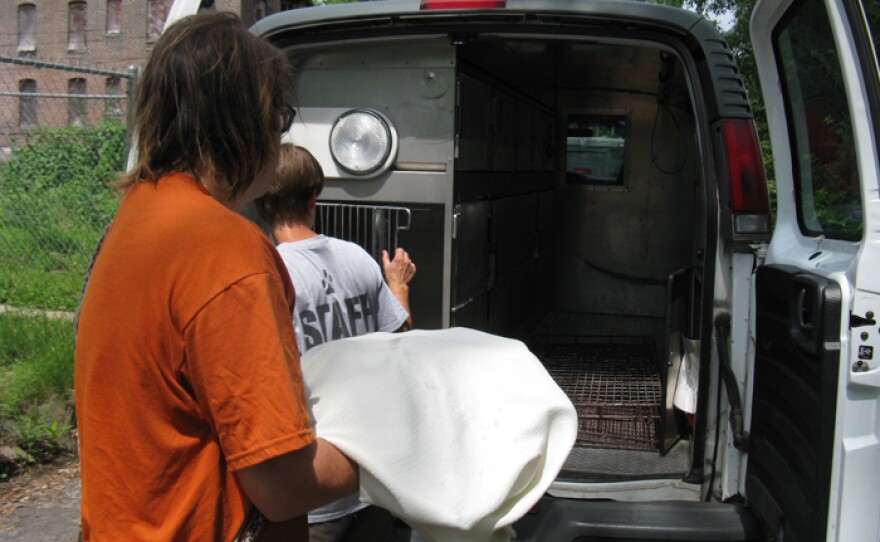http://stream.publicbroadcasting.net/production/mp3/national/local-national-976404.mp3
Last year, 90 dogs left the St. Louis city pound for what Mayor Francis Slay hoped would be a better life. The move marked the end of an attempt by the city to replace its aging pound with a state-of-the-art shelter funded by donations.
From that day on, Stray Rescue - a non-profit with 24 employees and an army of volunteers - cared for all but a handful of dogs and answered the city's animal control calls: all without taking a dime of city money.
If you believe the city’s health department, there are fewer strays on the street, and more dogs are being adopted. But there are questions about how long the success will last.
------------
On a hazy, humid Monday in June, Stray Rescue executive director Randy Grim punches an address into the GPS unit in his organization's Jeep and begins navigating the vehicle through the streets of St. Louis.
A clipboard at his side holds the Citizens Service Bureau calls that came in over the weekend. His top priority today is a report of nine dogs and 15 cats left for five days in an abandoned home on Cottage Avenue.
Breaking in
Grim drives the Jeep into the alley behind the home and confronts his first obstacle - a locked gate. Five minutes and a pair of bolt cutters later, he's in the backyard.
Grim calls for back-up. If the report is correct, the Jeep can't hold all the animals that are supposedly inside the house. He can hear barking from inside, a sound he says tears him up.
Then a second obstacle emerges. An open basement door doesn't lead to the rest of the house. Grim and Donna Lochmann, another Stray Rescue employee, resort to climbing in a front window and opening the door from inside, where they're greeted by two skinny black pups and the overpowering stench of urine and feces.
There are just two living animals in the house, though Grim and Lochmann later make a gruesome discovery. A third dog - maybe a sibling - has died, and the carcass was the only source of food for the other pups. Grim, disgusted, is in tears.
Darrell Antalick, a third Stray Rescue employee, has arrived with the transport van. Antalick, Lochmann and Grim load the two surviving pups along with the body of the third, and Grim is off to the next call. A family has reported a stray pit bull wandering around Vera St.
Grim tells the woman who called that Stray Rescue offers a program called "Shelter in Place," where the agency donates food and veterinary care and provides counseling to keep an animal in its home. But the woman refuses, saying the family already has a dog, and the pit bill joins Grim in the Jeep.
The third call is a report of a large white pit bull terrifying residents on Ridge Ave. Randy spots the dog, who he suspects was once part of a fighting ring. The dog is dangerous, and while Grim once would have rescued it and worked with it, he no longer has the time. He'll call animal control to have the dog picked up and taken to the old city pound on Gasconade, which houses the dangerous and bite dogs.
By the end of the day, Stray Rescue will have taken in six dogs.
"This time last year, I would get 20-30 a day."
Even at the slower pace, Stray Rescue's new role is an expensive proposition. Grim says his operating budget has more than doubled.
"We don't have a lot of money," Grim says. "I think right now in the bank we have $150,000 to spend in operations and $150,000 to spend on construction. We have to raise over $50,000 a week."
Sometimes, the agency doesn't make it, though it usually averages out. Grim won't take city money, saying it comes with too many strings, though he does want the funds from a tax check-off that were originally intended for the never-built city shelter in south St. Louis.
City health director Pamela Rice Walker is a leading architect of the new animal control strategy. Grim, she says, has done a lot to turn the organization from his personal passion into a more professional operation. John Garcia, whose rescue organization handled the Michael Vick pit bulls, is Stray Rescue's new director of operations. There's also a full-time fundraising and marketing person.
But Walker says the city has to help.
"We have to reduce intake," Walker says. "When you don’t want your dishwasher anymore, you don’t call the street department and say hey, I don’t want my dishwasher anymore, come and get it. But the attitude about dogs is, I don’t want my dog anymore, come get it, pick it up off my front porch, take it, I don’t care what you do with it, kill it if you have to, I just don’t want it anymore."
The Board of Aldermen is set to consider three pieces of legislation Walker says will make a big difference. One would require pet owners to spay, neuter and microchip their animals, and put new restrictions on breeders. Another would give Grim the old Animal House Fund money, about $255,000. A third would preserve the tax check-off but direct any new funds to programs that help low-income owners afford veterinary services.
The bills will run through Ald. Stephen Conway's committee. He plans to present them as an all-or-nothing package, a potentially tricky proposition since some of his members are critical of Grim.
Conway isn't fazed.
"If this is a problem in your community and your community wants it fixed, all of the experts say, from all of the different organizations, that this will work, this will diminish the problem. So you’re either for it, or you’re against it for some elusive reason," Conway says.
A request to rethink the strategy
Count Steven Kaufman, the executive director of the Animal Protective Association, among those who isn't sure the new strategy is working.
In March, Kaufman, along with the Humane Society of Missouri, sent a letter to Mayor Francis Slay calling for the merger of the city and the county animal control offices as soon as the county's new shelter opens.
The letter called the situation in the city "grave," citing a dramatic uptick in the number of city strays arriving at APA and HSMO facilities, and an increase in reports of stray animals forming packs.
"My concern is for the well-being of the animals and people," Kaufman says.
"With an increase of animals with nowhere to go, or with people that are frustrated and don’t have the ability to get through to an agency for those animals to be relinquished, they’re just abandoning those animals, or they’re taking them to the country and dumping them."
He also opposes mandatory spay-neuter laws, because they lead to more owners surrendering their pets, which Stray Rescue doesn't allow at its shelter. More and more of them show up at at the APA facility in Brentwood, Kaufman says, which is already crowded with strays.
By law, stray dogs must be held for five days.
"These are animals that are aggressive and that do have medical problems that aren't going to make them adoptable, yet we can't do anything with them for five days," Kaufman says. "So when we run out of space, health, adoptable animals have to be put to sleep."
Both Randy Grim and Pamela Walker fiercely deny that other facilities have been forced to take in more city strays since Grim took over.
"Any increase is because of the economy, foreclosures, evictions. It’s not because Stray Rescue is here," Grim says.
Sometimes, Grim says, it would be easier to give up, to go back to the old days when he answered to no one. In May, he almost did.
"When you don’t get the city support you want, the police support you want, the other shelter support you want, you feel alone with a huge problem to deal with," he says.
But then Grim shakes his head. No, he says, he wouldn't do that. That would mean letting down the animals in the city who need him.
More about Stray Rescue:




















